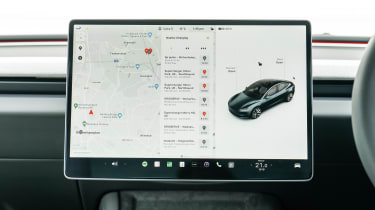Tesla Model 3 - Interior, design and technology
The Tesla Model 3 has a minimalist design, but the loss of stalks for major controls is infuriating at times

The Tesla Model 3 is probably not the most attractive car on the road, but we think it still manages to look upmarket without appearing overly flashy. The facelifted Model 3, with its slightly sharper front end, may well draw a few more admiring glances than the original. The latest Model 3 also gets a thinner set of headlights, while at the rear, there are C-shaped tail-lights, ‘Tesla’ badging across the bootlid, and a reprofiled bumper.
Those looking for a more aggressive-looking Model 3 should take a look at the high-performance, erm, Performance model. It’s got a big splitter and larger air intake in the front bumper, a carbon-fibre rear spoiler, a tweaked rear bumper, and forged 20-inch alloys to set it apart from the rest of the range.
The Model 3 sits on what’s known as a ‘skateboard’ chassis, with the drivetrain and batteries mounted as low in the car as possible. This creates more interior space than similarly-sized combustion-engine cars and decent storage areas at both the front and rear.
Ordering a Tesla Model 3 is an incredibly simple task: just pick which version you want, then the paint (Ultra Red looks good, but is an eye-watering £2000), the interior colour, and finally, which set of wheels you want. You can also add a tow hitch, or one of two upgraded versions of Tesla’s Autopilot driver-assistance system, but that’s your lot. Where the alternatives tend to have complex options lists, Tesla gives you most of it as standard.
What is the Tesla Model 3 like inside?
Take a seat inside, and the Model 3’s relatively conservative exterior is contrasted by a fastidiously minimalist interior. Tesla says the cabin of the all-electric saloon was ‘fully redesigned’ as part of its facelift, although it doesn’t look all that different from the original version to us. It’s still almost entirely dominated by a central 15.4-inch infotainment screen that controls all major (and minor) functions, and displays your speed and other vital driving information, while the air vents are tucked away neatly behind an otherwise plain dashboard.
Used - available now

2023 Tesla
Model 3
34,480 milesAutomaticElectric
Cash £20,700
2023 Tesla
Model 3
39,080 milesAutomaticElectric
Cash £19,200
2023 Tesla
Model 3
26,367 milesAutomaticElectric
Cash £22,400
2021 Tesla
Model 3
41,143 milesAutomaticElectric
Cash £18,063That giant display now has more usable space due to a thinner bezel, the front and rear seats are now ventilated and heated as standard, plus there’s ambient lighting along the top of the dash and doors.
One very obvious change is the steering wheel, which features buttons for the indicators in place of the traditional steering column stalks. For what reason? We’re not sure, and when we tested the setup ourselves, we found it was frustrating in certain situations, like when exiting roundabouts, or when you have to activate the indicators when the steering wheel isn’t in the straight-ahead position. It seems that Tesla might be admitting defeat on that front because the updated Tesla Model Y retains its indicator stalks, so hopefully, this will come back to the Model 3.
The updated Model 3 also ditches the gear selector stalk, using the central screen for gear selection instead, or preemptively putting you in the gear it thinks you’ll need, such as engaging reverse if the nose of the car is facing a wall.
We wish there were some physical buttons for the climate controls rather than Tesla forcing you to use the touchscreen to adjust everything from the heated and cooled seats to the direction of the airflow. At least those in the back no longer have to ask someone up front to adjust the temperature, as Tesla has added a small screen that gives them access to the rear climate controls. If passengers connect some Bluetooth headphones, it can also be used to watch YouTube and stream music on the move.
What is the interior quality like?
Tesla has worked on the Model 3’s interior quality as part of the facelift, and we’re pleased to say there’s been a marked improvement inside. The interior doesn’t feel quite as solid as the flawless cabin of the BMW i4, but it’s more on par with the other premium EVs it counts as rivals.
Sat-nav, stereo and infotainment
Tesla often has the feel of a tech firm first and a car company second, and the Model 3’s super-slick infotainment setup is at the cutting edge of what you’ll find in modern cars today.
The 15.4-inch touchscreen has the processing power to match its hi-res graphics. Loading times when plotting a route are rapid, and there’s minimal latency when responding to touches, pinches and swipes. Its precision with those inputs is impressive, too.
Roughly a third of the screen is reserved for driving information. Some will prefer to have a readout in front of them on a separate screen, but the numbers are large, so they’re not that hard to spot out of the corner of your eye.
There's no Apple CarPlay or Android Auto support, with Tesla preferring to use its own method of smartphone integration. We had no problems with Tesla's on-board system, however, and the sat-nav system is particularly impressive with its ability to plot charging spots on route, and also communicate with the car to tell it to prepare the battery to accept its maximum charging rate as soon as you plug in – something many rivals struggle with.








